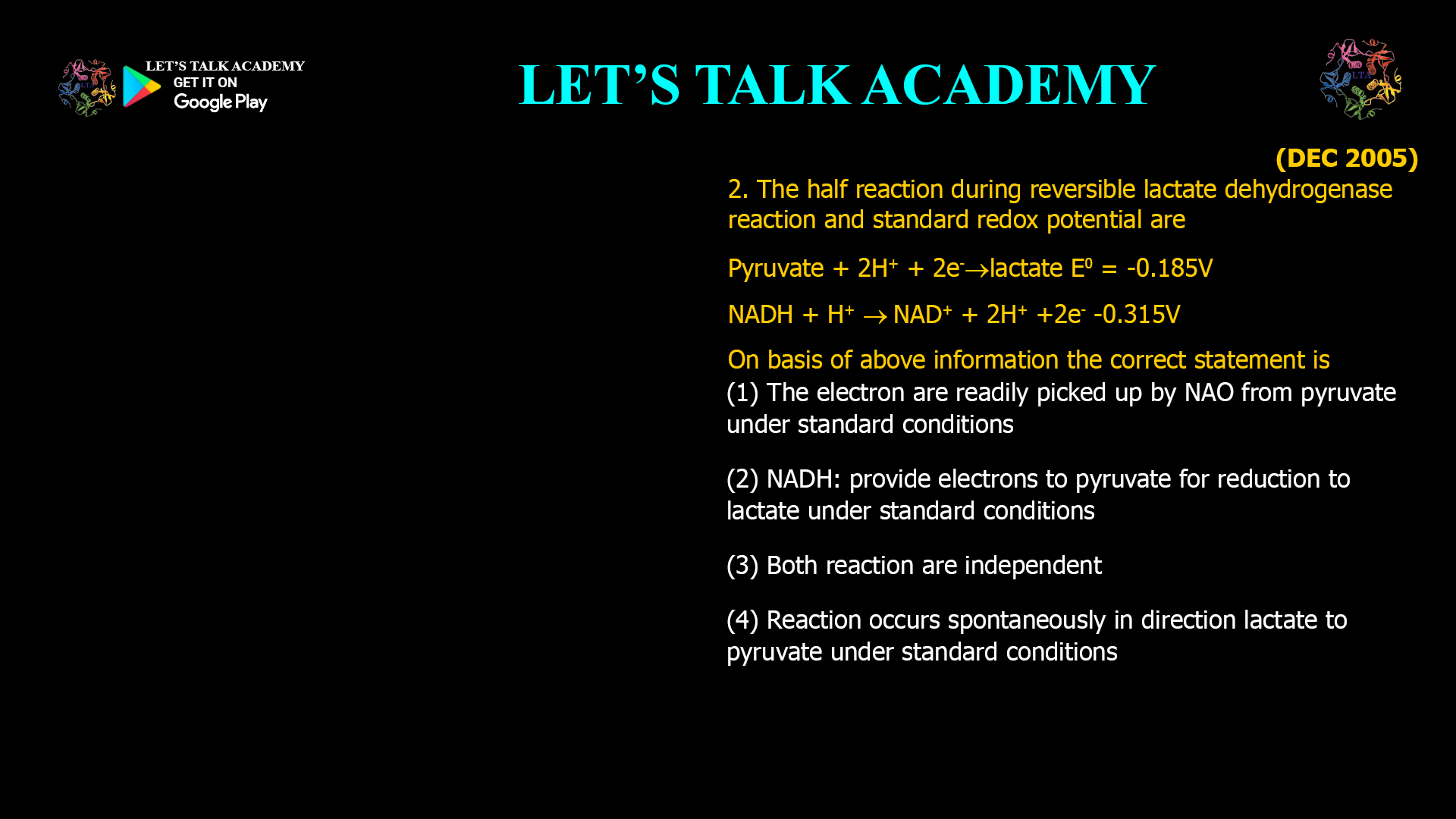- The half reaction during reversible lactate dehydrogenase reaction and standard redox potential are
Pyruvate + 2H+ + 2e– à lactate E0 = -0.185V
NADH + H+ à NAD+ + 2H+ +2e– -0.315V
On basis of above information the correct statement is
(1) The electron are readily picked up by NAO from pyruvate under standard conditions
(2) NADH: provide electrons to pyruvate for reduction to lactate under standard conditions
(3) Both reaction are independent
(4) Reaction occurs spontaneously in direction lactate to pyruvate under standard conditions
Lactate dehydrogenase (LDH) is a key enzyme catalyzing the reversible conversion between pyruvate and lactate, coupled with the interconversion of NADH and NAD+. This reaction plays a vital role in cellular metabolism, especially under anaerobic conditions, by regenerating NAD+ for glycolysis.
The half-reactions involved during the LDH-catalyzed process and their standard redox potentials (E0) are:
-
Pyruvate + 2H^+ + 2e^- → Lactate E0 = -0.185 V
-
NADH + H^+ → NAD^+ + 2H^+ + 2e^- E0 = -0.315 V
Interpreting Redox Potentials and Electron Flow
Redox potential indicates the tendency of a species to gain electrons (be reduced). A more positive E0 means a stronger oxidizing agent, while a more negative E0 indicates a stronger reducing agent.
Here, NADH has a more negative redox potential (-0.315 V) compared to pyruvate (-0.185 V). This means NADH is a better electron donor, while pyruvate is a better electron acceptor.
Electrons spontaneously flow from the species with lower redox potential (NADH) to the species with higher redox potential (pyruvate).
Evaluating the Statements
-
“The electrons are readily picked up by NAD from pyruvate under standard conditions.”
This suggests pyruvate donates electrons to NAD+, which contradicts the redox potentials. Pyruvate has a higher E0, so it is more likely to accept electrons, not donate. This statement is incorrect. -
“NADH provides electrons to pyruvate for reduction to lactate under standard conditions.”
NADH, with a more negative E0, donates electrons to pyruvate, reducing it to lactate. This matches the known biochemical pathway and redox potentials. This statement is correct. -
“Both reactions are independent.”
The two half-reactions are coupled in the LDH-catalyzed reaction; they depend on each other to maintain electron balance. This statement is incorrect. -
“Reaction occurs spontaneously in direction lactate to pyruvate under standard conditions.”
Since NADH has a lower redox potential, the spontaneous direction is from NADH to pyruvate (pyruvate reduction). The reverse reaction (lactate oxidation to pyruvate) is not spontaneous under standard conditions. This statement is incorrect.
Conclusion
Based on the redox potentials and the biochemical role of LDH, the correct statement is:
(2) NADH provides electrons to pyruvate for reduction to lactate under standard conditions.
Additional Insights
Lactate dehydrogenase catalyzes a reversible reaction, but under standard conditions, the direction favoring lactate formation from pyruvate is spontaneous due to the relative redox potentials. This reaction regenerates NAD+, essential for glycolysis, especially when oxygen is limited.
The enzyme mechanism involves NADH binding first, donating a hydride ion to pyruvate, converting it to lactate, while NADH is oxidized to NAD+. The reverse reaction, converting lactate back to pyruvate, requires different cellular conditions and is less favorable under standard conditions.
Understanding these redox relationships is crucial in biochemistry and medicine, as LDH activity is a marker for tissue damage and metabolic states.




6 Comments
Kirti Agarwal
September 24, 2025NADH provide electrons to pyruvate for reduction to lactate
Manisha choudhary
September 26, 2025Pyruvate s lactate formation anaerobic glycolysis m reverse reaction h
Pryruvate s lactate bnana spontaneous reaction h but lactate s pyruvate formation spontaneous nhi h
Heena Mahlawat
September 25, 2025Nadh provide electrons to pyruvate for reduction to lactate
Roopal Sharma
September 25, 2025Nadh provide electrons to pyruvate for reduction to lactate.
Minal Sethi
September 25, 2025NADH: provide electrons to pyruvate for reduction to lactate under standard conditions
Kajal
October 5, 2025Option 2is correct